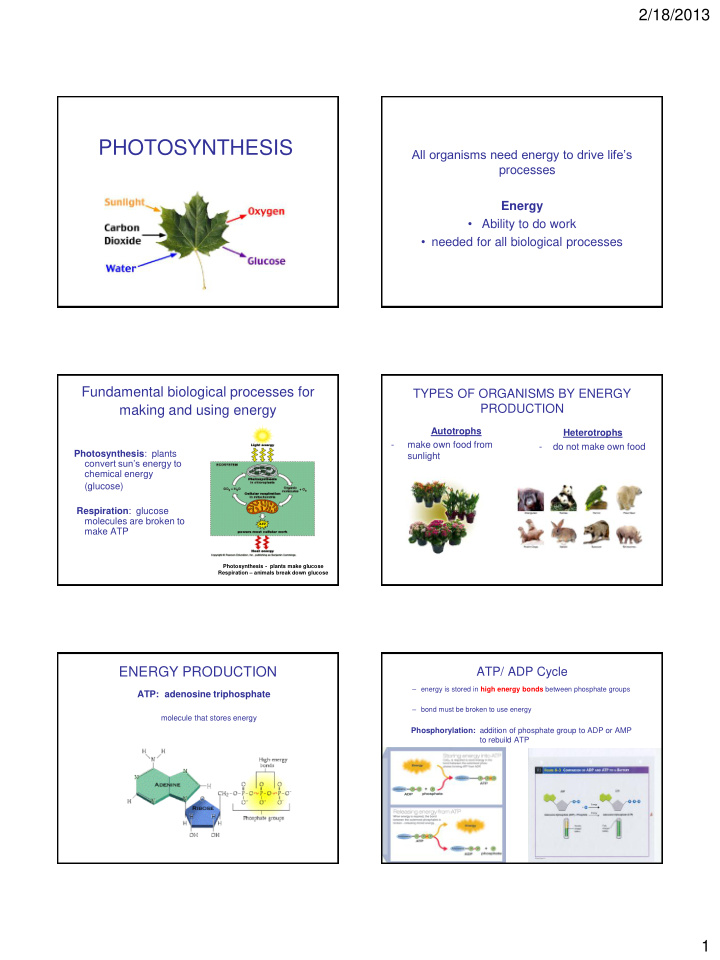



2/18/2013 PHOTOSYNTHESIS All organisms need energy to drive life’s processes Energy • Ability to do work • needed for all biological processes Fundamental biological processes for TYPES OF ORGANISMS BY ENERGY making and using energy PRODUCTION Autotrophs Heterotrophs - make own food from - do not make own food Photosynthesis : plants sunlight convert sun’s energy to chemical energy (glucose) Respiration : glucose molecules are broken to make ATP Photosynthesis - plants make glucose Respiration – animals break down glucose ENERGY PRODUCTION ATP/ ADP Cycle – energy is stored in high energy bonds between phosphate groups ATP: adenosine triphosphate – bond must be broken to use energy molecule that stores energy Phosphorylation: addition of phosphate group to ADP or AMP to rebuild ATP 1
2/18/2013 DISCOVERY OF PHOTOSYNTHESIS Redox reactions : involve transfer of energy • Jean Van Helmont (Dutch) – grew tree from small seedling - oxidation : loss of electrons (H atom) – after 5 years was 75 kg (mass of soil unchanged) loss of energy – CONCL: change came from CO 2 - reduction : gain of electrons (H atom) • Priestly (100 years later) English – put candle in jar – went out gain of energy – put plant in jar, candle stayed lit – CONCL: PLANT GAVE OFF O 2 needed for burning **when one substance is oxidized, another must be reduced** • Ingerhaousz (Dutch) – did same experiment but showed O 2 produced only when plant exposed to light – CONCL: light necessary for plant to produce O 2 Location of photosynthesis PHOTOSYNTHESIS 6 CO 2 + 6 H 2 O + light energy C 6 H 12 O 6 + 6 O 2 Chloroplast • process whereby autotrophs (plants) take in light energy and convert it to chemical energy (sugar) Thylakoid discs (photosystems) capture sunlight contain chlorophyll location of light reactions Stroma outside grana location of Calvin Cycle Photosynthetic pigments Pigment : substance that absorbs light (located in thylakoids of chloroplasts) • in photosynthesis: absorbed light energy is used to make chemical • energy chlorophyll a (green) • wavelengths not absorbed are reflected (color we see) - main photosynthetic pigment - directly involved in converting light chemical energy - hides other pigments • chlorophyll b, (green/yellow), carotenoids (orange, brown), xanthophylls (yellow) - accessory pigments - absorb light and transfers energy to chlorophyll a - seen in autumn when chlorophyll breaks down 2
2/18/2013 Overview of Stages of Photosynthesis STEPS OF LIGHT REACTIONS Light Reactions : (needs light) - occurs in thylakoid discs 1. photosystem II absorbs light and excites electrons of 4 basic processes chlorophyll a molecules - light absorption - electron transport - O2 production 2. excited electrons go into electron - ATP and NADPH production transport chain (makes ATP) - water is split and O2 is Calvin Cycle (Dark Reactions) : released into atmosphere - occurs after light reactions (can occur in light or dark) Purpose of photosystem II - occurs in stroma Make ATP - carbon attachment to glucose molecule 3. at end of electron transport chain electrons are passed to End products of light photosystem I reactions - electrons go thru separate 1. ATP AND NADPH: electron transport chain in needed to power Calvin photosystem I Cycle Purpose of photosystem I 2 . O2: by product make NADPH (from split water) released into atmosphere Steps of Calvin Cycle CALVIN CYCLE (DARK REACTIONS ) 1. Carbon fixation (from CO2 in air) - forms unstable 6 C sugar - light independent: can occur in light or 2. Regeneration of cycle darkness, always after light rxns - one carbon from attaches to glucose molecule - other carbons start cycle over - occurs in stroma again (cyclical) - purpose: Carbon attachment to glucose End product of Calvin Cycle Glucose molecule (from CO2 in atmosphere) 6 turns of cycle needed to make 1 molecule of glucose 3
2/18/2013 Factors Affecting Rate of Photosynthesis 1. light intensity - high intensity = high rate - levels off after certain intensity because pigments can only absorb so much light 2. CO2 levels - same mechanism as light 3. temperature - higher temp = higher rate - if temp goes too high, enzymes denature, rate slows down 4
Recommend
More recommend